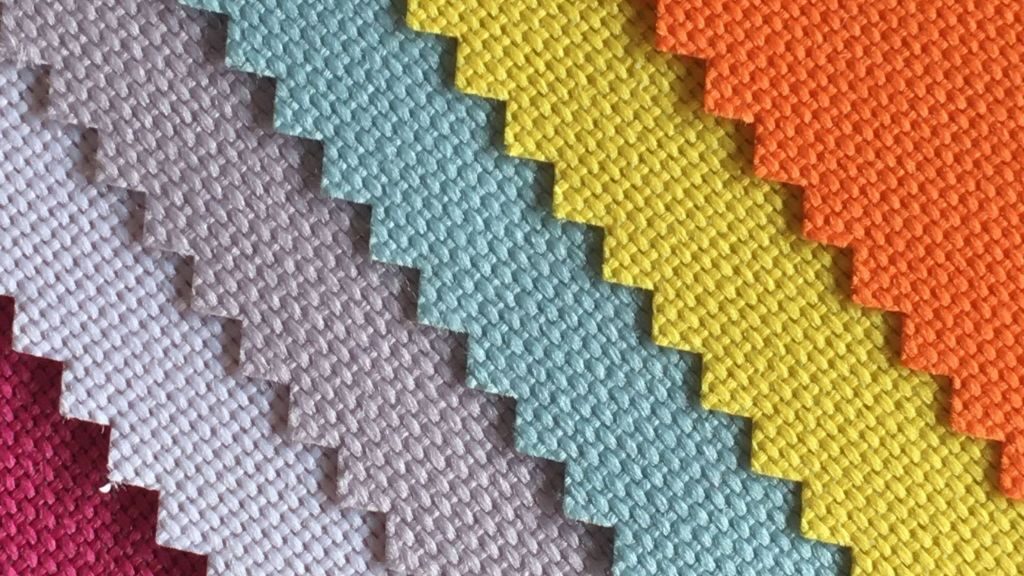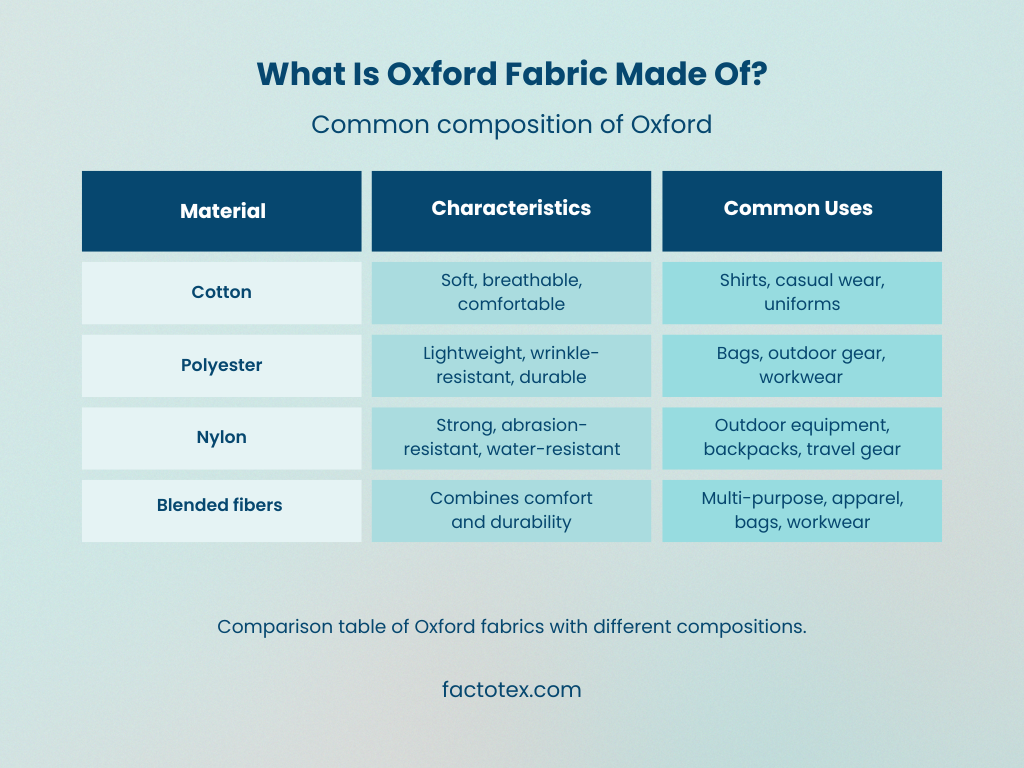Textile Fabric Guide: What Is Oxford Fabric?

Oxford fabric, also known as Oxford cloth, is a versatile and durable textile widely used in clothing, bags, and outdoor gear. It is known for its exceptional durability, strength, and water resistance. But what exactly is Oxford fabric? What makes it stand out among other fabrics and become an indispensable part of our lives? This blog will explore Oxford fabric from multiple perspectives, covering its definition, composition, types, common uses, and differences compared to other fabrics. If you’re interested in this fabric, start reading!
What Is Oxford fabric?
Origins of Oxford Fabric
Oxford fabric originated in 19th-century Britain, and its name comes from the world-renowned “Oxford University”. At that time, students and professors at Oxford University generally wore shirts made of this fabric. Due to its durability and comfort, it quickly became an iconic garment on campus. Initially, Oxford fabric was primarily used for formal dress shirts, its thick yet soft feel making it ideal for both everyday wear and formal occasions.
As time passed, Oxford fabric gradually entered the broader consumer market, becoming one of the most popular fabrics around the world. Its distinct basket weave structure provides both strength and comfort, which has made it suitable not only for shirts but also for bags, home goods, and outdoor equipment.
Key Characteristics of Oxford Fabric
Exceptional Durability: The weave of Oxford fabric makes it highly resistant to wear and tear. The fine basketweave structure significantly enhances the fabric’s strength, meaning it holds up well even with frequent use and friction.
Breathability: Although Oxford tends to be thicker due to its weave, it still maintains good breathability. Its porous nature allows air to circulate, making it suitable for use in clothing and accessories.
Low Maintenance: One of the outstanding features of Oxford cloth is its wrinkle resistance and easy cleaning. It is not easy to deform or fade. Additionally, its water resistance (especially when made from polyester or nylon blends) makes it great for outdoor products.
Variety of Textures and Thicknesses: Depending on the weave and fiber combination, Oxford can be adjusted for different thicknesses to suit various applications. The lighter versions are perfect for shirts, while the thicker ones are great for bags, tents, and others.
Advantages of Oxford Weave Structure
Oxford weave is a unique and durable weaving technique known for its basket-like structure. In this weaving method, the warp (vertical) and weft (horizontal) yarns are interlaced, creating an alternating grid pattern. Typically, the weft consists of two or more yarns, while the warp can be a single yarn or multiple, depending on the desired texture. The warp yarns are usually denser, which adds to the fabric’s stability and durability.
Compared to traditional plain weave or twill weave, the basket weave not only gives the fabric extra strength, but also adds a dense feel.
Plain Weave vs Oxford Weave: Plain weave is the most basic weaving technique, where each warp yarn alternates over and under each weft yarn in a simple, alternating pattern. This creates a smooth, flat fabric surface, making it ideal for lightweight fabrics used in shirts, blouses, and curtains.
On the other hand, Oxford weave uses a basket-like structure, where two or more warp yarns are interwoven with two or more weft yarns in a crisscross pattern. This creates a textured, dimensional fabric that enhances durability and strength, making it suitable for fabrics used in dress shirts, bags, outdoor gear, and workwear.
Twill Weave vs Oxford Weave: Twill weave is known for its diagonal pattern, formed when the warp yarns pass over and under the weft yarns in a staggered manner. This creates a distinct “V” or diagonal line on the fabric’s surface, providing excellent durability and wrinkle resistance. Fabrics woven in this pattern, like denim or chinos, are ideal for heavier garments such as jackets and trousers.
In contrast, Oxford weave produces a textured, grid-like pattern, offering a more three-dimensional surface. Its varying densities make it adaptable for different applications, from lightweight to durable garments.
What Is Oxford Fabric Made Of?
Oxford fabric can be made from natural fibers or synthetic fibers, and the choice of material directly impacts its texture, durability, and purpose. Common materials for Oxford cloth include cotton, polyester, nylon, and various blended fibers. Below is a comparison of these materials:

Types of Oxford Fabric
Classified by Weave and Texture
Classic Oxford: The most common type, Classic Oxford uses a simple basket weave. Its rougher texture offers good abrasion resistance, but its breathability is slightly lower than other types.
Pinpoint Oxford: Pinpoint Oxford is a finer, more tightly woven version of Classic Oxford. Due to its finer weave, the fabric surface is smoother and softer, with a more elegant and refined appearance. This type of Oxford cloth is commonly used for business shirts and high-end casual shirts.
Royal Oxford: Royal Oxford uses a more complex weaving method that gives the fabric a subtle sheen. Its higher density and unique weave make it softer and shinier than the basic version. Known for its luxurious allure, it’s often seen in high-fashion or formal settings.
Ripstop Oxford: Ripstop Oxford is made using thicker threads and a special interlacing technique that creates a grid pattern. This structure greatly enhances the fabric’s tear resistance, making it especially tough for high-stress applications. It’s commonly used in outdoor gear, military equipment, and any product where extreme durability is needed.
Classified by Material Composition
Cotton Oxford: Made entirely from natural cotton fibers, cotton oxford cloth is soft, comfortable and breathable. However, it tends to wrinkle easily and has poor water resistance.
Polyester Oxford: Made of synthetic polyester fiber, this fabric is lightweight, durable, wrinkle-resistant and fade-resistant. It is often used in making bags, outdoor equipment, and work uniforms due to its water-resistant properties.
Nylon Oxford: Constructed from nylon fibers, this version offers excellent tear and abrasion resistance, making it ideal for use in harsh conditions. It’s commonly used for backpacks, travel luggage, and outdoor equipment that needs to withstand extreme environments.
Blended Oxford (e.g., Cotton-Polyester Blend): Blended Oxford fabrics combine the best qualities of natural and synthetic fibers, such as cotton’s softness with polyester’s durability and wrinkle resistance.
Classified by Denier and Function
Denier refers to the thickness of the yarn used. The higher the denier, the thicker and stronger the fabric. Common Denier specifications include:
210D: Light and durable, suitable for small backpacks, raincoats, and light equipment.
300D: For medium-sized backpacks and everyday bags, offering good durability and strength.
420D, 600D: Heavy-duty, used for large outdoor backpacks, tents, and waterproof covers.
900D, 1000D: Extremely tough, ideal for heavy-duty backpacks and luggage, withstanding extreme conditions.
These functional Oxford fabrics are specially treated to meet specific needs:
Waterproof Oxford Fabric: Coated or treated to resist water, used in outdoor gear, raincoats, tents, and bags.
UV-Resistant Oxford Fabric: Designed to block UV rays, commonly used in outdoor tents, sunshades, and umbrellas.
Fire-Resistant Oxford Fabric: Treated to be flame-resistant, ideal for firefighter uniforms and fireproof gear.
What Are the Common Uses of Oxford Fabric?
For Apparel
If you want to create comfortable and breathable Oxford fabric shirt, Cotton Oxford is an excellent choice. Oxford cotton is known for its natural fiber properties, offering excellent comfort and breathability. It offers a crisp, classic business-casual look while keeping you cool throughout the day. However, if you’re looking for increased durability and easy maintenance, cotton polyester oxford could be a better choice. This blend combines the softness of cotton with the wrinkle resistance and durability of polyester, making it more resilient to frequent washing and prolonged wear. It’s an excellent choice for those who need clothing that can withstand regular washing (work shirts or everyday wear).
For Bags and Outdoor Gear
For items that need to withstand the rigors of daily wear or outdoor adventures, polyester or nylon Oxford fabric is the perfect option. These materials are strong and durable, often with a protective coating like PU or PVC. They are highly water-resistant and capable of withstanding heavy loads and harsh environments.
For Upholstery
Oxford fabric is also quite popular in home décor. Polyester Oxford, known for its fade resistance, durability, and ease of cleaning, is often used for sofa covers, seat cushions, and throw pillows. While cotton-polyester blends combine the comfort of cotton with the durability of polyester. This combination ensures the fabric will last a long time, making it an ideal choice for frequently used home accessories.
FAQ:
Q: What is 600D Oxford fabric?
A: 600D Oxford fabric refers to a durable Oxford cloth made with 600 Denier yarns. It is relatively thick, strong, and abrasion-resistant, making it ideal for backpacks, luggage, and heavy-duty outdoor gear.
Q: How to print on Oxford fabric?
A: Printing on Oxford fabric usually requires specialized techniques due to its textured surface. Common methods include digital printing, heat transfer, and sublimation (for polyester blends).
Q: Is Oxford fabric good for making bags?
A: Yes, Oxford fabric is widely used for bags. Its durability, resistance to wear and tear, and sometimes water resistance make it an excellent choice for backpacks, travel bags, and handbags.
Q: Can Oxford fabric be used for formal wear?
A: Yes, finer Oxford fabrics, such as pinpoint or royal Oxford, are commonly used for dress shirts and business casual attire. They provide a textured yet smooth appearance suitable for formal occasions.
Q: How does Oxford fabric compare to poplin?
A: Oxford fabric is thicker, more textured, and generally more durable than poplin. Poplin is smooth, lightweight, and crisp, ideal for lightweight dress shirts, while Oxford is better for casual shirts, workwear, and applications requiring higher durability.
Working With Facto Textile
We promise you:
- A wide variety of high- quality fabrics
- Full range of customized services
- Professional production technology
- Sincere Cooperation
Contact Us To Start Your Fabric Project
Please send us your message, we will reply within 20 hours.
